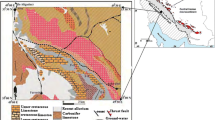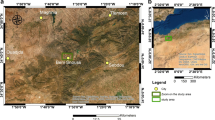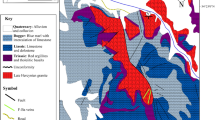Abstract
To determine the origin of the Kohlou barite deposit, comprehensive studies on petrography, rare earth element (REE) geochemistry, oxygen and sulfur isotopes, and fluid inclusions were performed. The Kohlou deposit is located 70 km northwest of Tafresh town in Markazi Province, Iran. Barite mineralization occurs as a stratabound manto at the contact of an overlying Eocene-aged volcano-sedimentary sequence with an underlying limestone horizon. Barite is accompanied by subordinate Fe- and Mn-oxides, calcite, and quartz. Field evidence including the presence of barite veinlets cross cutting host tuffs, and the brecciated host rocks cemented by barite suggest an epigenetic origin for the mineralization. The concentration of ∑REE is very low in barites, ranging from 0.22 to 16.41 ppm. Chondrite-normalized REE patterns show LREE enrichment relative to HREE, and mostly negative La and Ce anomalies. Gadolinium (Gd) anomalies vary from negative to positive in barite samples. The Ce/La and Y/Ho ratios, as well as La and Gd anomalies confirm a terrestrial source for barite from the Kohlou deposit. The δ18O and δ34S isotopic ratios in barites fall in narrow ranges of 1.7–2.7‰ and 14.6–16.3‰, respectively, implying that sulfate originated most likely from adjacent Miocene evaporites, with minor components of magmatic sulfur and oxygen carried in mineralizing fluids. Plots of δ34S versus δ18O do not show any similarity to barites from main modern marine and pedogenic settings, while overlap with the field represented by continental barite. Salinity values in fluid inclusions range from 8.28 to 23.25 wt% NaCl + CaCl2 equivalent. Homogenization temperatures occupy the range of 139–272 °C. Fluid inclusion data indicate that basinal fluids, with minor contribution from meteoric water, were the source of mineralizing solutions. It is concluded here that faulting and brecciation of the host rocks provided the pathways needed for the upward migration of the basinal Ba-rich solutions. Barite precipitated where Ba-bearing fluids interacted evaporite deposits.











Similar content being viewed by others
References
Abidi R, Slim-Shimi N, Marignac C, Hatira N, Gasquet D, Renac C, Soumarin A, Gleeson S (2012) The origin of sulfate mineralization and the nature of the BaSO4–SrSO4 solid-solution series in the Ain Allega and El Aguiba ore deposits, Northern Tunisia. Ore Geol Rev 48:165–179
Agard P, Omrani J, Jolivet L, Whitechurch H, Vrielynck B, Spakman W, Monie P, Meyer B, Wortel R (2011) Zagros orogeny: a subduction-dominated process. Geol Mag 148:692–725
Alaminia Z, Sharifi M (2018) Geological, geochemical and fluid inclusion studies on the evolution of barite mineralization in the Badroud area of Iran. Ore Geol Rev 92:613–626
Alavi M (1994) Tectonics of the Zagros Orogenic Belt of Iran: new data and interpretations. Tectonophysics 229:211–238
Alexander BW, Bau M, Andersson P, Dulski P (2008) Continentally derived solutes in shallow Archean seawater: rare earth element and Nd isotope evidence in iron formation from the 2.9 Ga Pongola Supergroup, South Africa. Geochim Cosmochim Acta 72:378–394
Bao SX, Zhou HY, Peng XT, Ji FW, Yao HQ (2008) Geochemistry of REE and yttrium in hydrothermal fluids from the Endeavour segment, Juan de Fuca Ridge. Geochem J 42:359–370
Bau M, Dulski P (1996) Distribution of yttrium and rare earth elements in the Penge and Kuruman iron-formations, Transvaal Supergroup, South Africa. Precambr Res 79:37–55
Bodnar RJ (1993) Revised equation and table for determining the freezing point depression of H2O–NaCl solution. Geochim Cosmochim Acta 57:683–684
Bodnar RJ (1999) Hydrothermal solutions. In: Marshall CP, Fairbridge RW (eds) Encyclopedia of geochemistry. Kluwer Academic Publishers, Lancaster, pp 333–337
Boroughs S, Wolff JA, Ellis BS, Bonnichsen B, Larson PB (2012) Evaluation of models for the origin of Miocene low-δ18O rhyolites of the Yellowstone/Columbia River Large Igneous Province. Earth Planet Sci Lett 313–314:45–55
Brock-Hon AL, Robins CR, Buck BJ (2012) Micromorphological investigation of pedogenic barite in Mormon Mesa petrocalcic horizons, Nevada USA: implication for genesis. Geoderma 179–180:1–8
Crockford PW, Wing BA, Paytan A, Hodgskiss MSW, Mayfield KK, Hayles JA, Middleton JE, Ahm ASC, Johnston DT, Caxito F, Uhlein G, Halverson GP, Eickmann B, Torres M, Horner TJ (2019) Barium-isotopic constraints on the origin of post-Marinoan barites. Earth Planet Sci Lett 519:234–244
Derakhshi MG, Hosseinzadeh MR, Moayyed M, Maghfouri S (2019) Metallogenesis of Precambrian SEDEX-type barite–(Pb–Cu–Zn) deposits in the Mishu mountain, NW Iran: constrains on the geochemistry and tectonic evolution of mineralization. Ore Geol Rev 107:310–335
Ehya F (2012) Rare earth element and stable isotope (O, S) geochemistry of barite from the Bijgan deposit, Markazi Province, Iran. Mineral Petrol 104:81–93
Ehya F, Mazraei SM (2017) Hydrothermal barite mineralization at Chenarvardeh deposit, Markazi Province, Iran: evidences from REE geochemistry and fluid inclusions. Afr Earth Sci 134:299–307
Forjanes P, Astilleros JM, Fernández-Díaz L (2020) The formation of barite and celestite through the replacement of gypsum. Minerals 10:189
Ganji A (2015) Barite mineralization in Iran. VI. BALKANMINE, Petrosani 2015
Ghasemi A, Talbot CJ (2006) A new tectonic scenario for the Sanandaj–Sirjan Zone, Iran. J Asian Earth Sci 26:683–693
Ghorbani M (2013) The economic geology of Iran, mineral deposits and natural resources. Springer Geology, Dordrecht. https://doi.org/10.1007/978-94-007-5625-0
Gleeson SA, Yardley BWD, Munz IA, Boyce AJ (2003) Infiltration of basinal fluids into high-grade basement, South Norway: sources and behaviour of waters and brines. Geofluids 3:33–48
Goldstein RH, Reynolds TJ (1994) Systematics of fluid inclusions in diagenetic minerals. SEPM short course notes, vol 31. SEPM Society for Sedimentary Geology, pp 199
González-Sánchez F, González-Partida E, Canet C, Atudorei V, Alfonso P, Morales-Puente P, Cienfuegos-Alvarado E, González-Ruiz L (2017) Geological setting and genesis of stratabound barite deposits at Múzquiz, Coahuila in northeastern Mexico. Ore Geol Rev 81:1184–1192
Greaves MJ, Elderfield H, Klinkhammer GP (1989) Determination of the rare earth elements in natural water by isotope-dilution mass spectrometry. Anal Chim Acta 218:265–280
Griffith EM, Paytan A (2012) Barite in the ocean-occurrence, geochemistry and palaeoceanographic applications. Sedimentology 59:1817–1835
Griffith EM, Paytan A, Wortmann UG, Eisenhauer A, Scher HD (2018) Combining metal and nonmetal isotopic measurements in barite to identify mode of formation. Chem Geol 500:148–158
Guichard F, Church TM, Treuil M, Jaffrezic H (1979) Rare earths in barites: distribution and effects on aqueous partitioning. Geochim Cosmochim Acta 49:983–997
Hanor JS (2000) Barite-celestite geochemistry and environments of formation. Rev Mineral Geochem 40:193–263
Hodaie Keveshk H, Ehya F, Rostami Paydar G, Maleki Kheymehsari S (2021) Rare earth elements geochemistry, O and S isotopic compositions, and microthermometric data of barite from the Kuh-Ghalagheh deposit, Markazi Province, Iran. Appl Geochem 135:105128
Hoefs J (2009) Stable isotope geochemistry, 6th edn. Springer, Berlin
Johnson CA, Kelley KD, Leach DL (2004) Sulfur and oxygen isotopes in barite deposits of the western Brooks Range, Alaska, and implications for the origin of the Red Dog massive sulfide deposits. Econ Geol 99:1435–1448
Johnson CA, Emsbo P, Poole FG, Rye RO (2009) Sulfur- and oxygen-isotopes in sediment-hosted stratiform barite deposits. Geochim Cosmochim Acta 73:133–147
Kharaka YK, Hanor JS (2003) Deep fluids in the continents: I. Sedimentary basins. Treatise Geochem 5:605
Kyser TK (2007) Fluids, basin analysis, and mineral deposits. Geofluids 7:238–257
Lawler JP, Crawford ML (1983) Stretching of fluid inclusions resulting from a low-temperature microthermometric technique. Econ Geol 78:527–529
McDonough WF, Sun SS (1995) The composition of the earth. Chem Geol 120:223–253
McRae ME (2017) Barite-2015 [advance release]. U.S. geological survey minerals yearbook-2015
Mohajjel M, Fergusson CL, Sahandi MR (2003) Cretaceous-Tertiary convergence and continental collision, Sanandaj-Sirjan zone, Western Iran. J Asian Earth Sci 21:397–412
Pattan JN, Pearce NJG, Mislankar PG (2005) Constraints in using Cerium-anomaly of bulk sediments as an indicator of paleo bottom water redox environment: a case study from the Central Indian Ocean Basin. Chem Geol 221:260–278
Paytan A, Kastner M, Campbell D, Thiemens MH (1998) Sulfur isotopic composition of Cenozoic seawater sulfate. Science 282:1459–1462
Paytan A, Mearon S, Cobb K, Kastner M (2002) Origin of marine barite deposits: Sr and S isotope characterization. Geology 30:747–750
Radfar J, Kohansal R (undated) Farmahin quadrangle map 1:100000. Geological Survey of Iran
Rajabzadeh MA (2007) A fluid inclusion study of a large MVT barite–fluorite deposit: Komshecheh, Central Iran. Iran J Sci Technol 31:73–87
Roedder E (1984) Fluid inclusions. Reviews in mineralogy, vol 12. De Gruyter, Berlin
Saintilan NJ, Spangenberg JE, Chiaradia M, Chelle-Michou C, Stephens MB, Fontboté L (2019) Petroleum as source and carrier of metals in epigenetic sediment-hosted mineralization. Sci Rep 9:8283
Shepherd TJ, Ranbin AH, Alderton DHM (1985) A practical guide to fluid inclusion studies. Blackie, Glasgow, p 239
Shields G, Kimura H, Yang J, Gammon P (2004) Sulphur isotopic evolution of Neoproterozoic-Cambrian seawater: new francolite-bound sulphate δ34S data and a critical appraisal of the existing record. Chem Geol 204:163–182
Steele-MacInnis M, Bodnar RJ, Naden J (2011) Numerical model to determine the composition of H2O–NaCl–CaCl2 fluid inclusions based on microthermometric and microanalytical data. Geochim Cosmochim Acta 75:21–40
Stevens EWN, Bailey JV, Flood BE, Jones DS, Gilhooly WP, Joye SB, Teske A, Mason OU (2015) Barite encrustation of benthic sulfur-oxidizing bacteria at a marine cold seep. Geobiology 13:588–603
Taylor HP (1968) The oxygen isotope geochemistry of igneous rocks. Contrib Miner Petrol 19:1–71
Turchyn AV, Schrag DP (2006) Cenozoic evolution of the sulfur cycle: insight from oxygen isotopes in marine sulfate. Earth Planet Sci Lett 241:763–779
Verdel C, Wernicke BP, Hassanzadeh J, Guest B (2011) A Paleogene extensional arc flare-up in Iran. Tectonics 30:TC3008
Wu Q, Jiang X, Lu Q, Li J, Chen J (2021) Changes in soil organic carbon and aggregate stability following a chronosequence of Liriodendron chinense plantations. J For Res 32:355–362
Zarasvandi A, Zaheri N, Pourkaseb H, Chrachi A, Bagheri H (2014) Geochemistry and fluid-inclusion microthermometry of the Farsesh barite deposit, Iran. Geologos 20:201–214
Acknowledgements
This research was conducted as partial fulfillment of the requirements for a Ph.D. degree in Economic Geology for the first author from the Behbahan Branch, Islamic Azad University. Funding this research was partly provided by the Iranian Mines and Mining Industries Development and Renovation (IMIDRO) Company, which is kindly acknowledged.
Author information
Authors and Affiliations
Corresponding author
Additional information
Publisher's Note
Springer Nature remains neutral with regard to jurisdictional claims in published maps and institutional affiliations.
Rights and permissions
About this article
Cite this article
Keveshk, H.H., Ehya, F., Paydar, G.R. et al. The Kohlou barite deposit, Markazi Province, Iran: studies on rare earth element geochemistry, O and S isotopes, and fluid inclusions. Carbonates Evaporites 37, 38 (2022). https://doi.org/10.1007/s13146-022-00785-2
Accepted:
Published:
DOI: https://doi.org/10.1007/s13146-022-00785-2




